Our planning application for three wind turbines at Ascog Farm was submitted to Argyll & Bute Council on 10 October 2012 and validated by them on 29 October 2012 following the provision of further drawings and maps.
Following submission of the application, after what has probably been a year long build-up documented on these pages, we were surprised by the calm before the storm, with only one letter (again on the frightening subject of ‘infrasound’ and ‘low frequency noise’) to The Buteman received from another of our ardent anti-wind/anti-development anywhere-in-or-near-Ascog campaigners.
In this week’s Buteman it’s time to catch up. Brace yourselves for a lot of content. It’s a bumper wind edition with coverage on pages 1, 2, 3, 4 and 5!
News and Editorial
Credit is due to The Buteman’s Editor Craig Borland and Reporter Karen Keith for covering the Ascog wind energy project impartially over an extended period, and in the face of an active and vocal opposition group.
On the front page we have:
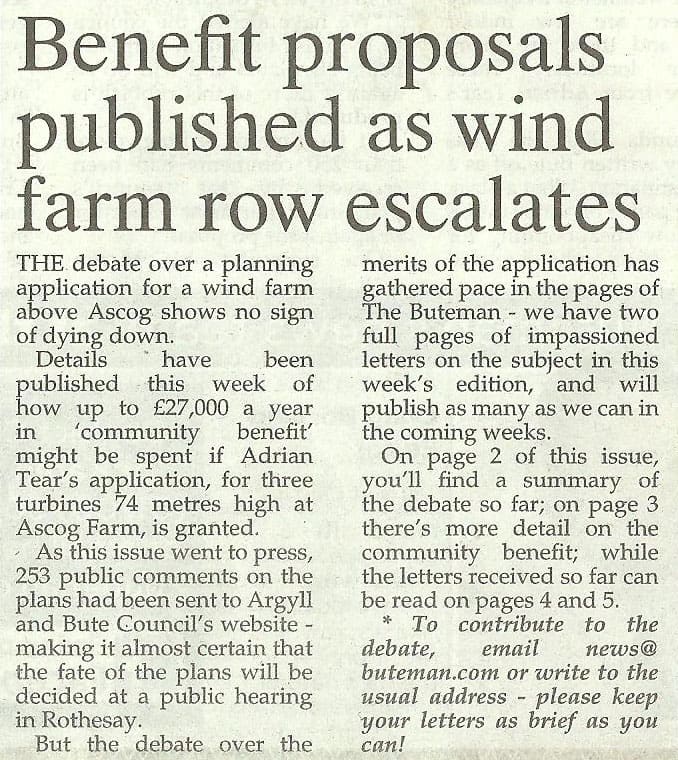
©The Buteman
If planning permission for our three 900kW turbines (2.7mW total capacity) is granted, we will contribute £10,000/mW installed capacity/year OR 20% net profit/year (whichever is the greater) to our chosen community partner Towards Zero Carbon Bute.
As the article on page 3 of The Buteman makes clear this could add up to a lot of money over the years, and is way more financially generous than Scottish Power Renewables’ benefits of £21,000/year filtering into Colintraive and Glendaruel from their 35 turbine, 30mW capacity installation.
So £10,000/mW community benefit from a local, privately owned operation compares to, if The Buteman’s figures are correct, £700/mW from a multi-million pound company. Once the loan for capital expenditure is paid off and the project starts to generate profit the community contributions will be even higher.

©The Buteman
We believe, in line with the Scottish Government, that harnessing renewable energy can bring real benefits to communities and are pleased, as Mr Salmond has stated, that ‘Scotland intends to play a lead role in the low carbon revolution, just as a couple of centuries back we played a lead role in the industrial revolution.’
Needless to say though, it’s a contentious issue and – as with onshore wind farm applications made practically anywhere – there are those who will (and who are perfectly entitled to) object to the planning authorities.

©The Buteman
Rather than dwelling on many of the familiar generic arguments against wind turbines we would encourage people to read the Environmental Statement (2.9MB PDF) predicting impacts at Ascog Farm and nearby from any wind turbine development.
The Buteman’s Editorial closes the news and articles section.
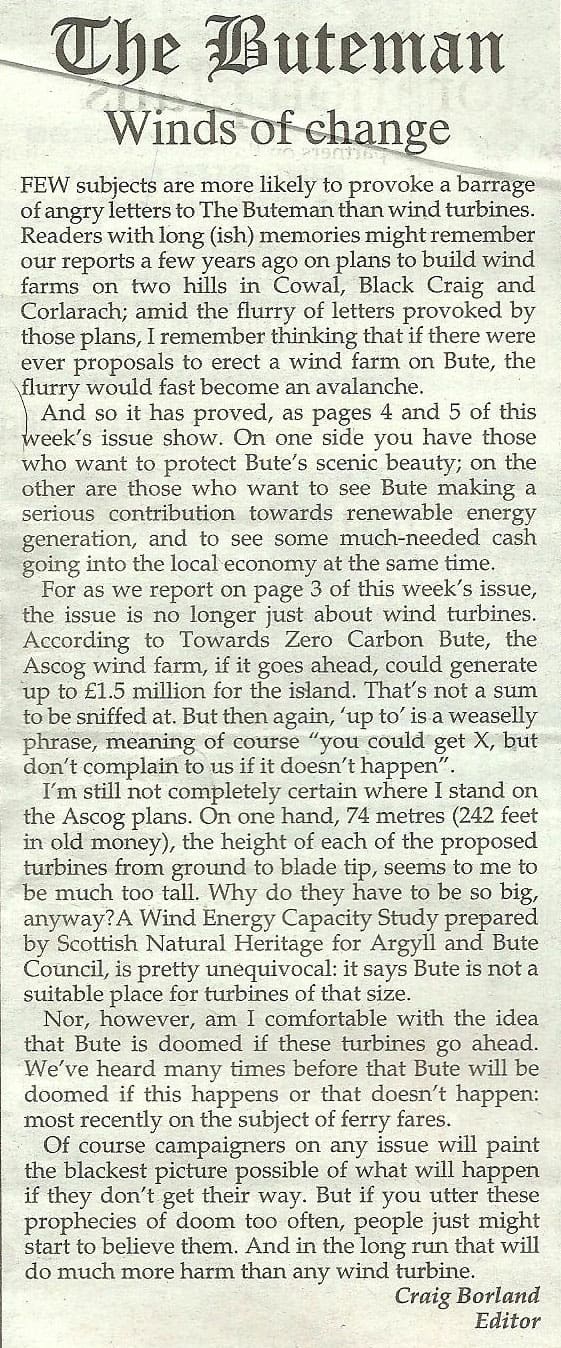
©The Buteman
The Editor isn’t certain that wind turbines will single-handedly ‘doom’ Bute.
Let’s see what the letter writers – usually a more vociferous bunch – make to that assertion.
Letters
The letters open up on page 4 of the paper and in fairness to the authors are reproduced below in the order in which they appeared.
Mr Harry Reid of Millburn Cottage, Ascog, is first off the mark with a letter titled ‘Elephant in the room?’

©The Buteman
Alluding, in common anti-wind parlance, to images of rape or desecration Mr Reid is ‘appalled at the proposal to violate the appearance of Bute…[with] grotesque and massive wind turbines.’ He further states:
- ‘Global warming stopped 16 years ago in 1996.’ One could write for weeks on this subject but instead we would suggest readers take the time to consult a major scientific study published by the World Bank warning of the dangers of a warming world or simply read some of the recent articles on the subject on the BBC News web site.
- ‘Why are we throwing money at ridiculous, infinitely profitable schemes like this windfarm?’ In part, of course, the answer to this depends on whether you submit to the possibility that man-made activities (primarily fossil fuel burning) have or will have some impact on climate or whether you subscribe to the ‘natural fluctuations’ school of thought. We cannot read Mr Reid’s mind unfortunately so do not know. We do know, however, that the Scottish Government supports the development of renewables and – through CARES – have helped us pay some, but by no means all, of the significant costs of producing a detailed Environmental Statement into the proposals. Community Energy Scotland considers Ascog Farm a potentially viable site and worthy of examination at planning. If consent is granted the CARES loan is repaid (with interest at 10%). If turbines are built this will be at a cost, of some £3.5 million, to us and at our risk. The wind might not blow for the next twenty years, or interest rates might soar. Regardless, we hope to get the project off the ground and to make community benefits that – once capital is paid off – will be 20% of net profit. How many other businesses on Bute or elsewhere are making those sorts of commitments?
Next up a letter from yours truly. It’s ‘Despicable’ what those objectors get up to!
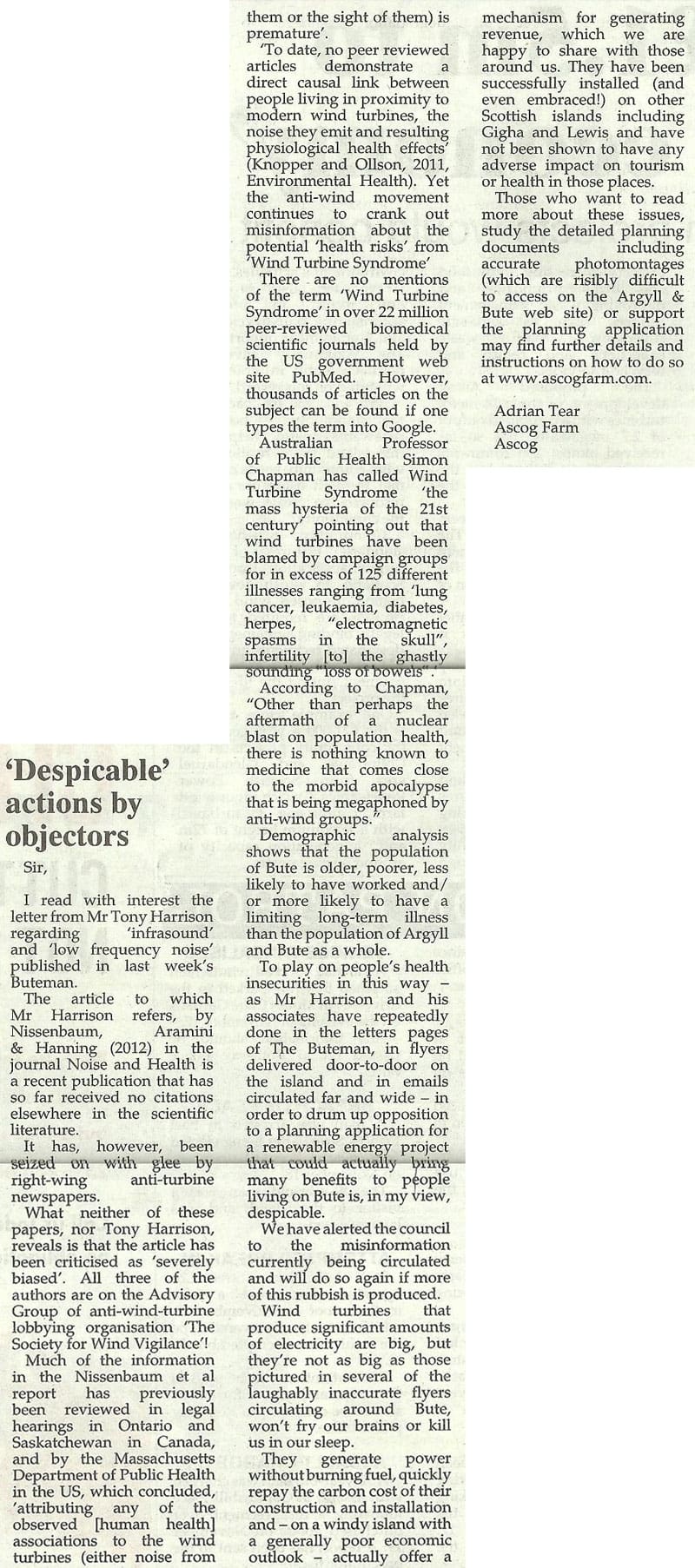
©The Buteman
Some, of course, will feel that our own plans to develop a wind energy project at Ascog Farm are ‘despicable’ – but a lot of effort by impartial experts has gone into the production of the Environmental Statement and, like it or not, it is a proposal we are allowed to put before the planning authorities.
Mr Bruce Gittings of Cameron March, Edinburgh is next up with a letter warning about the ‘Climate of fear’ over the wind farm.

©The Buteman
Mr Gittings makes the point that ‘we all have to make a contribution to carbon reduction’ and notes that ‘Bute makes little contribution to the generation of the electricity it uses’. That’s certainly true for now. Let’s hope we can make some changes in the electricity generation department in due course…
Next up Mr Alec Mack of Castle Street, Port Bannatyne with a letter titled ‘Quick to criticise wind power, slow with solutions’.

©The Buteman
Mr Mack ends his letter, rather elegantly, by stating that ‘the simple fact is that, as a society, we will have to be creative in finding solutions that ensure that the lights will not go out and that our children are not lumbered with irreversible problems caused by our inaction.’ We hope that renewable wind energy generation at Ascog Farm forms part of that solution.
Mr John Thomas of Balmory Hall, Ascog is, unfortunately, less keen on the idea and warns that ‘Green energy would come at too great a cost’.
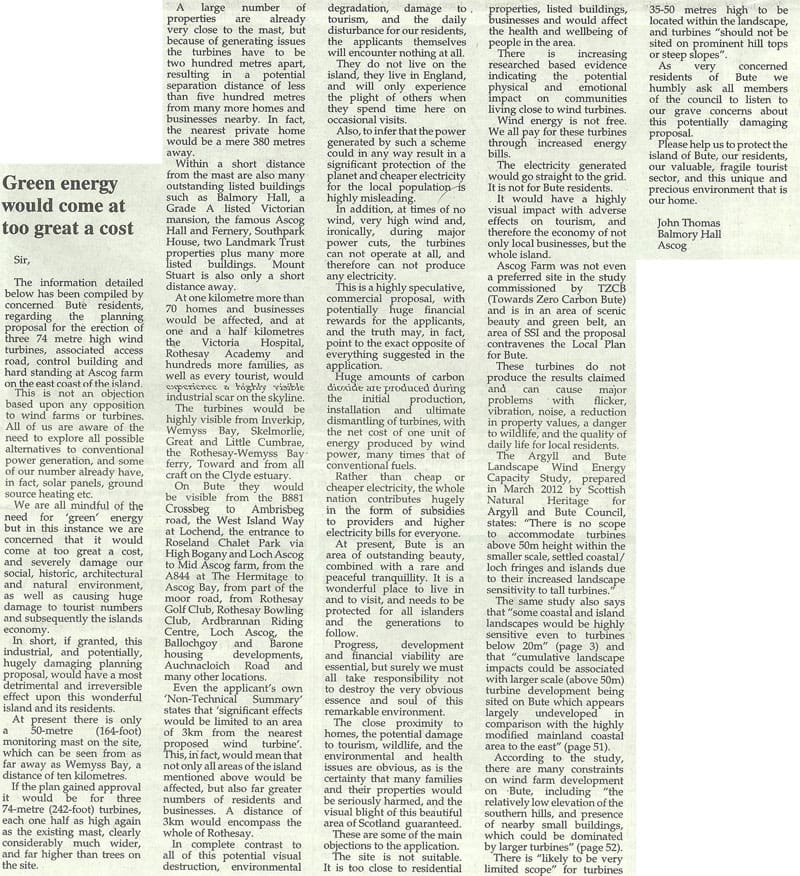
©The Buteman
In our view Mr Thomas’s letter can be summarised in the opening of his second paragraph, ‘We are all mindful of the need for green energy but…’
Those ‘buts’ – covered with an international perspective by The Economist – are apt to concern the same sorts of arguments about noise, views, tourism and birds that are repeated endlessly in every anti-wind campaign.
Mr Thomas is also keen to have a dig at us ‘the applicants [who] will encounter nothing at all [as] they do not live on the island, they live in England, and will only experience the plight of others when they spend time here on occasional visits.’
These, and a range of other jibes aimed in our direction over the last year or more, really are not relevant to the question of whether or not we can investigate the viability of the proposals and what we can do to benefit the community.
Mr Thomas’s other worry (as to where things can be sited, and what size of thing – if any – is permissible) will be decided by Argyll & Bute Council and/or the Scottish Ministers.
Lastly there’s an interesting letter – that was read out at length by Jean Moffat at the recent Bute Community Council meeting from Ms Susie Alcorn of Ascog Hall Gardens and Victorian Fernery, Ascog entitled ‘Mr Tear has written off Bute’.

©The Buteman
Ms Alcorn quotes correctly, if rather selectively, from some of the copy on this site and suggests that Adrian has ‘completely written Bute off as a tourist destination’ by painting a bleak picture ‘of our beautiful island’.
Few local people I speak to would disagree with the simple statement that ‘Bute is expensive to get to, the weather is frequently poor, there are few indoor activities and there are many alternative locations’. Tackling some of these problems has, indeed, been a focus for Bute Community Council, Argyll & Bute Council, VisitBute and others for years.
However, my statement was made in commentary on a letter to The Buteman received from a young mother who had recently visited the Island. It is, perhaps, worth recounting her words here:
|
Nothing to do on Bute
Sir, I came to Rothesay in the Easter holidays, bringing my two children aged six and 18 months. I was very disappointed to find absolutely nothing for us to do. The putting green was closed, the swimming pool was closed, and I can’t believe there is not even a park for the kids to play in on the front. We paid a lot of money on train and ferry fares only to get there and find there was nothing to do. We were very disappointed. It would be good to see some more things for day-trippers or holiday-makers to do, or I fear they will take their holidays elsewhere in the future which would be a shame for such a lovely island. Yours etc. |
Of course, Bute is – in many places and in many ways – a very beautiful island. Those who read this site more widely will find that:
- Our Location page (last modified 19 December 2011 16:43:34) proudly proclaims that ‘Ascog Farm is situated in a beautiful secluded position 300 metres from the Ascog shore on the Isle of Bute, Scotland.’
- The travel directions on the Location page regarding options to visit via Colintraive or Wemyss Bay (from Glasgow) state that ‘Both routes take approximately 1hr 45mins (including boats) and are equally scenic. It’s a good idea to come in one direction and go back in the other! ‘
- Our Links page (last modified 4 July 2012 12:00:14) states that ‘There is much to see and do both on and near the Isle of Bute’ and we include a link to Flickr that ‘has numerous photographs of Bute and the surrounding areas showing some of the fantastic scenery.’
- The Links page covers most of the main tourist attractions on Bute including the Ascog Hall Gardens and Victorian Fernery itself!
Ms Alcorn then cites the findings of a recent ‘Attitudes to turbines’ poll conducted by YouGov for the John Muir Trust. She is correct to state that, according to the findings, ’43 per cent of people in Britain who visit scenic areas in the UK for their natural heritage and beauty would be ‘less likely to visit a scenic area with a large concentration of wind farms’.’
What Ms Alcorn omits to report, unfortunately, is the raison d’etre for the survey and the focus on ‘wild land’. According to the John Muir Trust:
|
This is the first national poll to measure the level of public support for large scale wind farms in our valuable natural landscapes. It is also the first poll to gauge the potential impact on tourism in areas like the Scottish Highlands, where large scale wind projects have been built or are in the pipeline. Previous polls have sought only to measure general support for wind power. However, the Trust believes that it’s possible to support wind power while opposing the building of turbines on important areas of wild land.
[…] In Scotland, there are currently 176 windfarms (2,136 turbines) operational or under construction. 113 developments (981 turbines) have been approved that are not yet built. And 166 (1,667 turbines) are in planning. Throughout the world, wild land is a finite and diminishing resource. The John Muir Trust opposes inappropriate development on important areas of wild land in the UK – that is, large areas of high scenic and wildlife value, with minimal evidence of modern human development. |
| John Muir Trust (our emphasis) |
It would be very hard to argue that Bute has ‘minimal evidence of modern human development’. The Southern end (and Eastern side) of the Island, in particular, is characterised by the ‘ribbon’ development of Rothesay along the coast and the managed farmland initially cleared around 300 years ago.
Consequently, we agree entirely with the findings of the John Muir Trust that genuinely wild bits of land should be left as they are; distributed electricity generation is best placed near the population that consumes the power and that by definition has the grid that can transmit it. Wind energy generation should not be confined to areas that are genuinely wild simply because some people do not like to look at wind turbines or don’t want them near where they live!
Looking around, if we step just a few yards out of the house, turn back and look towards the Ayrshire coast we are met with the following view:
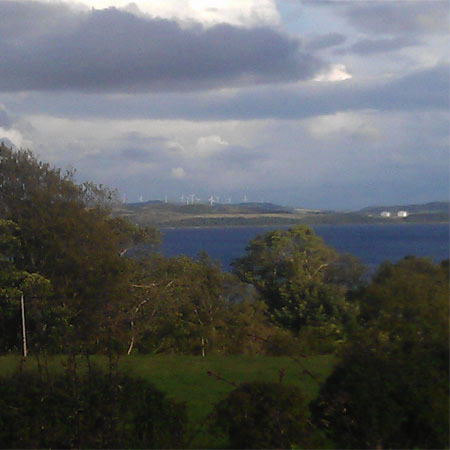
Turbines to the left of it, Nukes to the right!
Wind turbines are already a part of the landscape on Bute, along with a nearby nuclear plant (Hunterston B), coal plant (Hunterston), shipping lane (River Clyde) and a whole host of other things – some attractive to look ‘at’ or ‘out from’ (Scalpsie, Ettrick Bay, Dunagoil etc) and others less so (empty or derelict farms, buildings in poor repair in Rothesay etc).
Given the surroundings (and the findings of the recent Holyrood enquiry which has so far failed to report any definitive effects on tourism from wind renewables) we consider that the addition of three wind turbines on Bute is unlikely to have the cataclysmic effect on tourist visits to the Island that some fear.
Our outline plans for on-farm diversification, if we have the income to bring them to fruition, could indeed add interesting attractions to the Island either for recreation or to help visitors or the young understand the important part that Bute has played in Scotland’s Industrial Revolution.